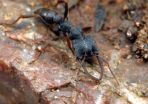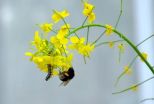(Press-News.org) The sun emitted a significant solar flare, peaking at 1:48 p.m. EDT March 29, 2014, and NASA's Solar Dynamics Observatory captured images of the event. Solar flares are powerful bursts of radiation. Harmful radiation from a flare cannot pass through Earth's atmosphere to physically affect humans on the ground, however -- when intense enough -- they can disturb the atmosphere in the layer where GPS and communications signals travel.
To see how this event impacted Earth, please visit NOAA's Space Weather Prediction Center at http://spaceweather.gov, the U.S. government's official source for space weather forecasts, alerts, watches and warnings.
This flare is classified as an X.1-class flare. X-class denotes the most intense flares, while the number provides more information about its strength. An X2 is twice as intense as an X1, an X3 is three times as intense, etc.
INFORMATION: END
NASA releases images of X-class solar flare
2014-03-31
ELSE PRESS RELEASES FROM THIS DATE:
Stats show growth of breast lifts outpacing implants 2 to 1
2014-03-31
VIDEO:
New statistics from the American Society of Plastic Surgeons show that since 2000, breast lift procedures have grown by 70 percent, twice the rate of breast implants. According to the...
Click here for more information.
ARLINGTON HEIGHTS, Ill., March 31, 2014 – New statistics released today by the American Society of Plastic Surgeons (ASPS) show that breast lift procedures are growing at twice the rate of breast implant surgeries. Since 2000, breast lifts have grown by ...
Comparison of drug-releasing stents show similar safety outcomes after 2 years
2014-03-31
A comparison of the safety of biodegradable polymer biolimus-eluting stents vs durable polymer everolimus-eluting stents finds similar outcomes for measures including death and heart attack after two years, according to a JAMA study released online to coincide with presentation at the 2014 American College of Cardiology Scientific Sessions.
Recent studies have raised concerns about the safety of biodegradable polymer drug-eluting stents (BP-DES) compared with durable polymer everolimus-eluting stents (DP-EES). The NOBORI Biolimus-Eluting vs XIENCE/PROMUS Everolimus-Eluting ...
Six new Dracula ants from Madagascar: Minor workers become queens in Mystrium
2014-03-31
Six new species of Dracula ants from the Malagasy region have been discovered by scientists at the California Academy of Sciences. The discoveries, by postdoctoral fellow Masashi Yoshimura from Japan and curator of entomology Brian L. Fisher, represent a completely new twist in the typically rigid caste system of ants, where anatomy is typically destiny. The study was published in the open access journal ZooKeys.
"The genus Mystrium is the most mysterious group within the bizarre Dracula ants," said Yoshimura.
Mystrium species have unique features such as long, spatulate ...
Study further illuminates heart-healthy benefits of Mediterranean diet
2014-03-31
(WASHINGTON, March 31, 2014) – New research further illuminates the heart-healthy benefits of the Mediterranean diet, tying the eating plan to lower levels of platelets and white blood cells, two markers of inflammation. Inflammation has an association with greater risk of heart attack and stroke. Study, results are published online today in Blood, the Journal of the American Society of Hematology (ASH).
The Mediterranean diet, characterized by generous servings of foods such as greens, whole grains, fish, and olive oil, has long been hailed as a heart-healthy eating ...
Scientists discover a number of novel genetic defects which cause oesophageal cancer
2014-03-31
A team of scientists from the Cancer Science Institute of Singapore (CSI Singapore) at the National University of Singapore and National University Cancer Institute Singapore (NCIS), and their collaborators from the Cedars-Sinai Medical Centre, UCLA School of Medicine, demonstrated that a number of novel genetic defects are able to induce oesophageal cancer.
The research group, led by Professor H. Phillip Koeffler, Senior Principal Investigator at CSI Singapore and Deputy Director of NCIS, has conducted a successful comprehensive genomic study of oesophageal squamous ...
What will climate policy mean for coal?
2014-03-31
Limiting climate change to 2°C means shutting down coal power plants - an unpopular proposition for coal power companies. But a new study shows that delaying climate policies could prove even worse for power plant owners.
Coal power plants are a major source of greenhouse gas emissions, and new plants are planned around the world, particularly in India and China. These new power plants are built to run for 30-50 years, paying off only after years of operation. But stringent climate policies could make the cost of emission so high that coal power generation is no longer ...
Online self-injury information often inaccurate, study finds
2014-03-31
People seeking help or information online about cutting and other forms of self-injury are likely finding falsehoods and myths, according to new research from the University of Guelph.
Only about 10 per cent of websites providing information about non-suicidal self-injury (NSSI) are endorsed by health or academic institutions, according to a study published recently in JAMA Pediatrics, a journal of the American Medical Association.
It's a troubling finding, says lead author Stephen Lewis, a Guelph psychology professor. "This is a salient public health issue," he said.
People ...
Tamiflu-resistant influenza: Parsing the genome for the culprits
2014-03-31
Tamiflu is one of the few available treatments for those who come down with the flu. But the virus quickly develops resistance; multiplying at a rate of several generations a day, these tiny pathogens rapidly accumulate genetic mutations. Because of this, they have a good chance of developing counterattacks to the antiviral. How can these infinitesimal variations be identified within the immensity of the virus' genetic code? EPFL researchers have created a computer tool that can shed light on the flu virus' formidable adaptability. They were able to find mutations that ...
Using different scents to attract or repel insects
2014-03-31
Flowering plants attract pollinating insects with scent from their flowers and bright colours. If they have become infested with herbivores like caterpillars, they attract beneficial insects like parasitic wasps with the help of scent signals from their leaves. The wasps then lay their eggs in the caterpillars and kill the parasites. Floral and foliar scents can, however, mutually reduce their attractiveness. That's why flowering plants face a dilemma: should they use their resources to attract pollinating insects and, by extension, for reproduction or should they invest ...
'Cosmic barometer' could reveal violent events in universe's past
2014-03-31
Exploding stars, random impacts involving comets and meteorites, and even near misses between two bodies can create regions of great heat and high pressure.
Researchers from Imperial College London have now developed a method for analysing the pressure experienced by tiny samples of organic material that may have been ejected from dying stars before making a long journey through the cosmos. The researchers have investigated a type of aromatic hydrocarbon called dimethylnaphthalene, which should enable them to identify violent events in the history of the universe.
Samples ...



